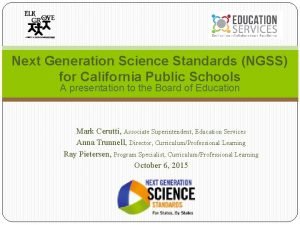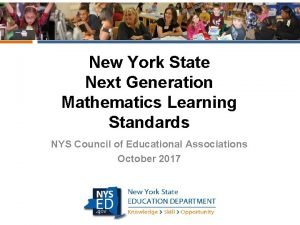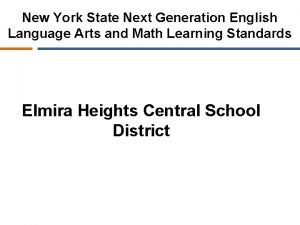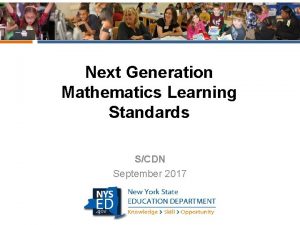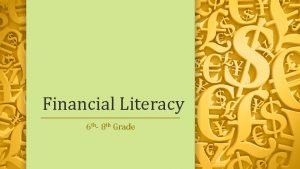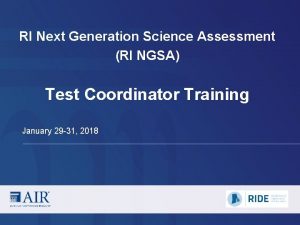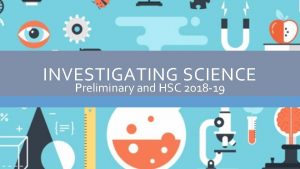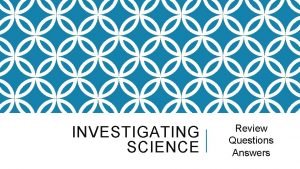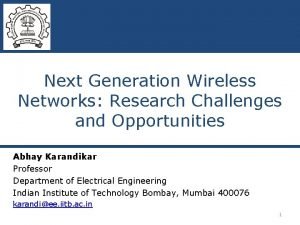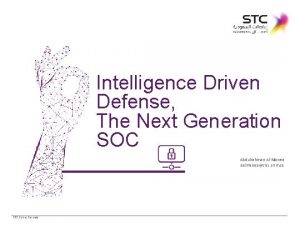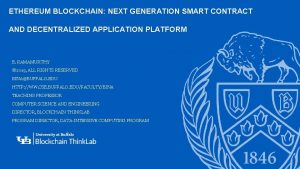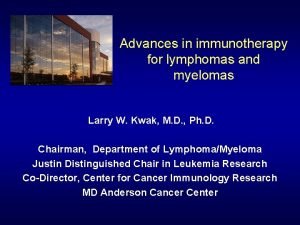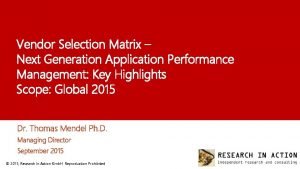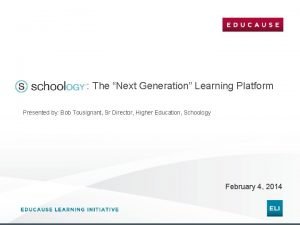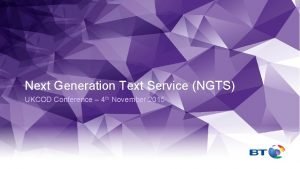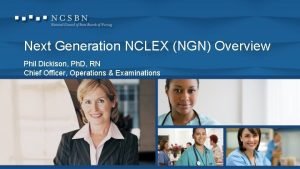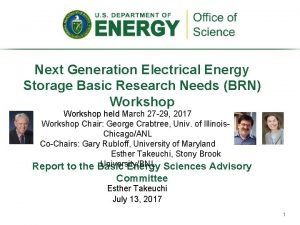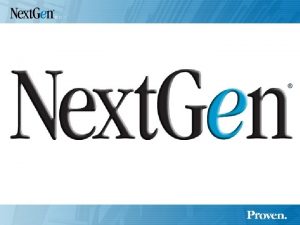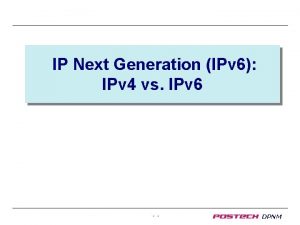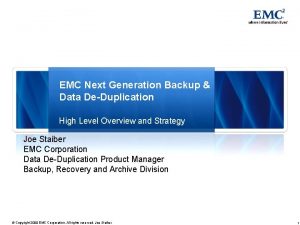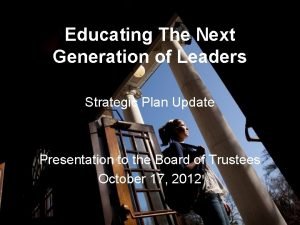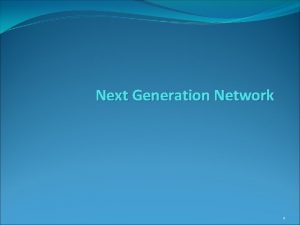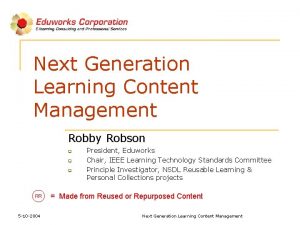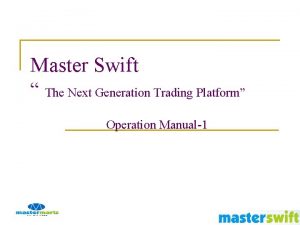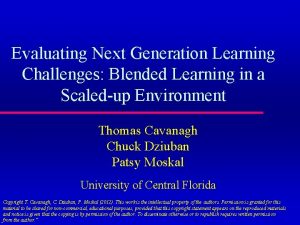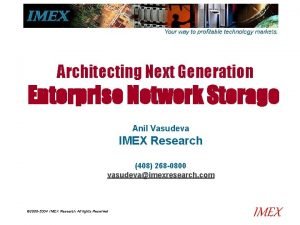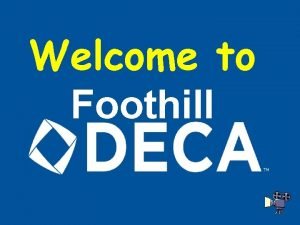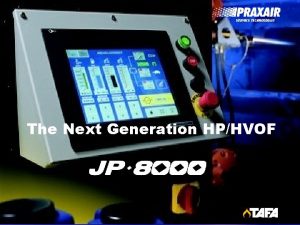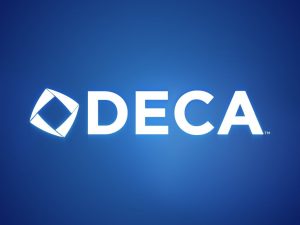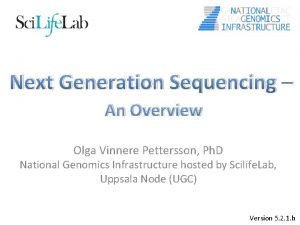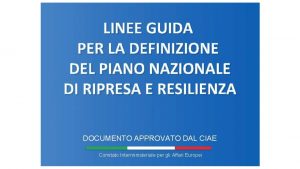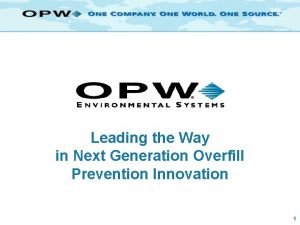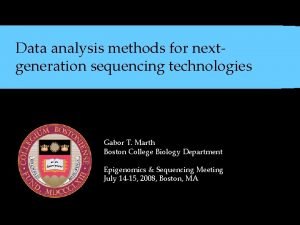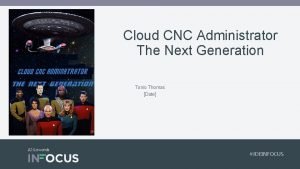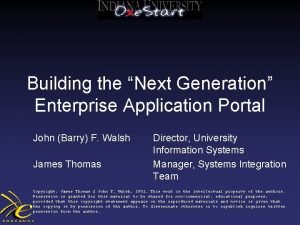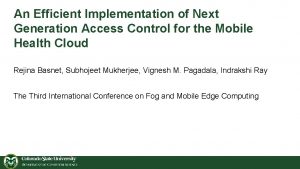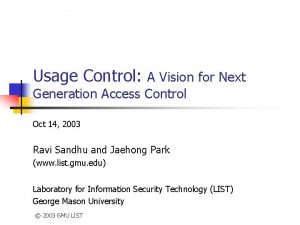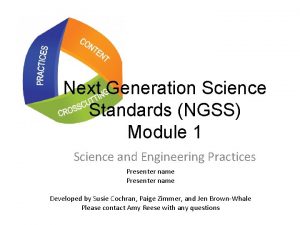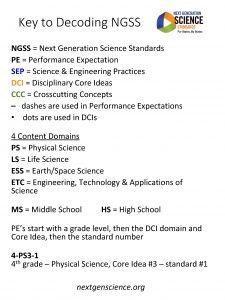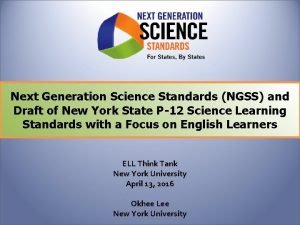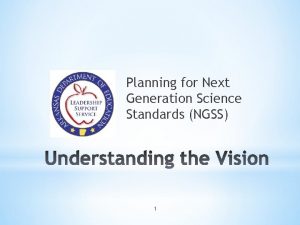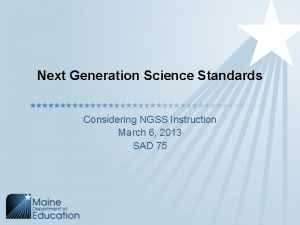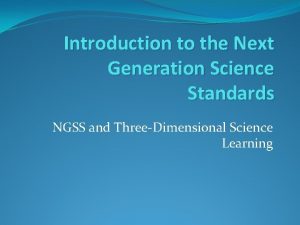Investigating the Next Generation Science Standards NGSS Kevin











































- Slides: 43

Investigating the Next Generation Science Standards (NGSS) Kevin Anderson, Ph. D. @CESA 2 STEM www. cesa 2. org/programs/wingss 1

AGENDA 9: 00 -10: 30 Structure of the NGSS and Example 10: 30 -10: 50 Conceptual Shifts and Implications 10: 50 -11: 00 Quick Break 11: 00 -11: 40 Lesson Planning within NGSS 11: 40 -12: 00 Progressions in the NGSS 12: 00 -12: 30 Next steps and Summing Up 2

Goals for the Day Be able to understand use the structure of the NGSS Compare and contrast the WMAS and NGSS Use an NGSS standard to design instruction Explore progressions of Practices and CCC Consider next steps

4

Why NGSS? Current Standards are out of date ◦ Advances in science & technology ◦ Advances in understanding of learning ◦ Links to CCSS College & Career Readiness ◦ More authentic science learning ◦ STEM integration ◦ Global competitiveness and job market

Building on the Past; Preparing for the Future Phase II 1990 s-2009 7/2011 – April 2013 1/2010 - 7/2011 6

State-led Effort The federal government is not involved in this effort. It is state-led, and states will decide whether or not to adopt the standards. The work undertaken by the NRC and Achieve is being supported by the Carnegie Corporation of New York. No federal funds have been used to develop the standards. 7

NGSS Standards Walk-Through Meaningful Logo 8

9

Performance Expectations 10

Foundation Boxes 11

Science & Engineering Practices Asking questions and defining problems Developing and using models Planning and carrying out investigations Analyzing and interpreting data Using mathematics and computational thinking Constructing explanations and designing solutions Engaging in argument from evidence Obtaining, evaluating, and communicating information 12

Science & Engineering Practices 13

Disciplinary Core Ideas 14

Disciplinary Core Ideas Life Science Physical Science LS 1: From Molecules to Organisms: Structures & Processes LS 2: Ecosystems: Interactions, Energy, & Dynamics LS 3: Heredity: Inheritance & Variation of Traits LS 4: Biological Evolution: Unity & Diversity of Life PS 1: Matter & Its Interactions PS 2: Motion & Stability: Forces & Interactions PS 3: Energy PS 4: Waves & Their Applications in Technologies for Information Transfer Earth & Space Science Engineering & Technology ESS 1: Earth’s Place in the Universe ESS 2: Earth’s Systems ESS 3: Earth & Human Activity ETS 1: Engineering Design ETS 2: Links Among Engineering, Technology & Society 15

Crosscutting Concepts 16

Crosscutting Concepts Patterns Cause and effect: Mechanism and explanation Scale, proportion, and quantity Systems and system models Energy and matter: Flows, cycles, and conservation Structure and function Stability and change 17

Connections Boxes 18

Group Review of a Lesson TASK: Find the sample lesson online: ◦ Intro - http: //its-about-time. com/pbis/pdf/samples/wea_challenge. pdf ◦ Activity - http: //its-about-time. com/pbis/pdf/ls/wea_ls 1. pdf ◦ Standard – MS-ESS 2 Earth’s Systems (DCI) or MS Weather and Climate Complete the lesson review for each dimension after we discuss it ◦ Disciplinary Core Ideas ◦ Science & Engineering Practices ◦ Crosscutting Concepts 19

Disciplinary Core Ideas Life Science Physical Science LS 1: From Molecules to Organisms: Structures & Processes LS 2: Ecosystems: Interactions, Energy, & Dynamics LS 3: Heredity: Inheritance & Variation of Traits LS 4: Biological Evolution: Unity & Diversity of Life PS 1: Matter & Its Interactions PS 2: Motion & Stability: Forces & Interactions PS 3: Energy PS 4: Waves & Their Applications in Technologies for Information Transfer Earth & Space Science Engineering & Technology ESS 1: Earth’s Place in the Universe ESS 2: Earth’s Systems ESS 3: Earth & Human Activity ETS 1: Engineering Design ETS 2: Links Among Engineering, Technology & Society 20

Group Review of a Lesson TASK: Complete the lesson review for Disciplinary Core Ideas 21

Science & Engineering Practices Asking questions and defining problems Developing and using models Planning and carrying out investigations Analyzing and interpreting data Using mathematics and computational thinking Constructing explanations and designing solutions Engaging in argument from evidence Obtaining, evaluating, and communicating information 22

Example Practice – Modeling Shayna had a small bottle of Bromine gas. The bottle was closed with a cork. She tied a string to the cork, and then placed the bottle inside a larger bottle. She sealed the large bottle shut (Figure 1). Next, Shayna opened the small bottle by pulling the string connected to the cork. Figure 2 shows what happened after the cork of the small bottle was opened. 1. Draw a model that shows what is happening in this experiment. 2. Explain in writing what is happening in your model. Figure 1 23

Group Review of a Lesson TASK: Complete the lesson review for Science & Engineering Practices 24

Group review of lesson • Science vs. engineering practices? What is the goal of the activity? • Is it to answer a question? If so, they are likely doing science. • Is the purpose to define and solve a problem? If so, they are likely doing engineering. 25

Engineering in the NGSS Engineering is… Cyclical problem-solving Based on a context (a story) Built upon science, math and technology know-how Dependent on effective communication and coordination Not a competition or just building something 26

Engineering in the NGSS Engineering resources… e. GFI - teachers. egfi-k 12. org/ Teach. Engineering. org PBS Design Squad www. cesa 2. org/programs/stem /engineering. cfm 27

Crosscutting Concepts Patterns Cause and effect: Mechanism and explanation Scale, proportion, and quantity Systems and system models Energy and matter: Flows, cycles, and conservation Structure and function Stability and change 28

Group Review of a Lesson TASK: Complete the lesson review for Crosscutting Concepts 29

Group Review of a Lesson TASK: Complete and discuss the final lesson review questions for… ◦ Evidence of Learning ◦ Performance Expectations ◦ CCSS Connections 30

CCSS ELA & Mathematics and the NGSS The practices among these subjects overlap. What are the important practice connections you see in these subjects? What other connections would you add? What does this suggest for your teaching? 31

What is Different about NGSS? TASK: Look at the provided WI Model Academic Standards & NGSS Standards Pages 32

What is Different about NGSS? TASK: How are the NGSS similar & different from old standards? Compare & contrast instruction under these standards as well. Discuss the changes that you see coming and be prepared to share out. 33

What Is Different about NGSS? Appendix A – Conceptual Shifts Shift 1 - NGSS Reflects “Real Science” Shift 5 - Nature of Science & Engineering are Integrated K-12 34

What Is Different about NGSS? Appendix A – Conceptual Shifts Shift 3 – NGSS Builds Coherently K-12 Shift 4 – NGSS Focuses on Deeper Understanding & Application 35

What Is Different about NGSS? Appendix A – Conceptual Shifts Shift 2 - NGSS is not a curriculum Shift 6 - NGSS & Common Core aligned 36

How will NGSS change teaching and learning? TASK: Take a few minutes to reflect on the conceptual shifts presented. Think-Pair-Share – Answer the questions on each page…discuss with a neighbor…be prepared to share. 37

Ub. D Planning and the NGSS What does lesson planning look like in the NGSS? Move to grade level groups as possible. Find the Understanding by Design template. Decide on one standards page and one or two performance expectations on that page. Collaboratively fill out the template for a lesson you may do to reach these goals. See example on back (rough). 38

What will I Teach with the NGSS? Go to appendices F and G – www. nextgenscience. org Reflect: ◦ Find one practice and one crosscutting concept that you see as especially important. ◦ What do the practices and crosscutting concepts look like K-12? ◦ What skills do students arrive with at your grade? ◦ What do they need to prepare for? 39

Next Steps How can we ensure that the full intent of the NGSS is implemented in our classroom, school, and district? 40

How do we get there? TASK – back to school level groups: Reflect upon the implementation of NGSS in your district. Identify basic steps, key players, additional resources, and obstacles to your implementation. Describe professional development needs in your district for successful NGSS implementation. 41

42

Thank You! Please complete the evaluation. Feel free to email me with questions: kevin. anderson@cesa 2. org www. cesa 2. org/programs/wingss www. cesa 2. org/programs/stem @CESA 2 STEM 43
 Ngss california
Ngss california X.next = x.next.next
X.next = x.next.next Next generation learning standards nys
Next generation learning standards nys Nys ela standards
Nys ela standards Investinwhatsnext
Investinwhatsnext Next gen math standards
Next gen math standards Next generation personal finance standards
Next generation personal finance standards Rhode island next generation science assessment
Rhode island next generation science assessment Investigating science hsc
Investigating science hsc Investigating science sample questions
Investigating science sample questions Stahl
Stahl From generation to generation we worship you
From generation to generation we worship you Palo alto traps gartner
Palo alto traps gartner Next generation wireless communication market
Next generation wireless communication market Clinical judgement measurement model
Clinical judgement measurement model Intelligence driven defense
Intelligence driven defense Next-generation smart contracts
Next-generation smart contracts Vaccine therapy
Vaccine therapy Next generation application management
Next generation application management Next generation learning platform
Next generation learning platform Sinkhole palo alto
Sinkhole palo alto Next generation text service
Next generation text service Nclex next generation
Nclex next generation Next generation electrical technologies
Next generation electrical technologies Next gen emr
Next gen emr Ip next generation
Ip next generation Next generation backup
Next generation backup Educating the next generation of leaders
Educating the next generation of leaders Apa itu ngn
Apa itu ngn Robson management corporation
Robson management corporation Trading platform
Trading platform Next generation learning challenges
Next generation learning challenges Next generation enterprise network
Next generation enterprise network Foothill deca
Foothill deca The next generation
The next generation Deca mission statement
Deca mission statement Craig wenter
Craig wenter Fondi next generation eu
Fondi next generation eu The next generation
The next generation Next generation sequencing methods
Next generation sequencing methods Cnc administrator
Cnc administrator Onestart iu login
Onestart iu login Next generation access control
Next generation access control Usage control model
Usage control model
